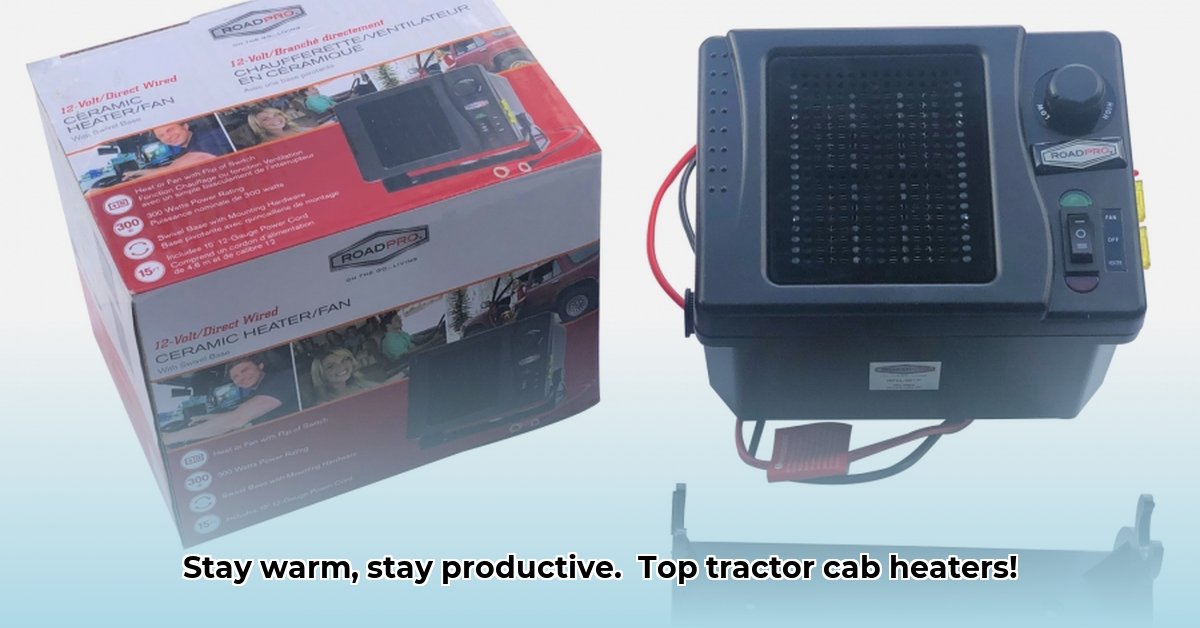
Cab Heater Tractor: Conquer Winter, Boost Your Bottom Line
Winter's icy grip significantly reduces farm productivity. Frozen hands, numb feet, and overall discomfort hinder efficiency. A tractor cab heater is the solution, boosting comfort, health, and ultimately, profits. It's an investment in a successful harvest. For more information on cab heaters, see this helpful resource.
The Untapped Potential of a Toasty Tractor Cab
Imagine working for hours in sub-zero temperatures. A warm cab transforms this ordeal, allowing for longer workdays, increased acreage coverage, and higher yields—directly impacting your bottom line. Beyond increased productivity, consider the health benefits. Prolonged cold exposure leads to various health issues. A heated cab mitigates this risk, improving worker well-being and consistency. It's a win-win situation: better health and improved financial gains.
Choosing the Right Heating System for Your Tractor: A Buyer's Guide
Selecting the right cab heater requires careful consideration of several factors:
1. Power Requirements: Matching Volts
Your tractor uses either 12V or 24V electricity. The heater must be compatible; otherwise, you risk damage and potential hazards. Consult your tractor's manual to verify the voltage. This is crucial for safety and functionality.
2. Heating Capacity: BTUs for Effective Warming
Heating capacity (BTUs – British Thermal Units) determines the heating speed and thoroughness. Higher BTUs generally mean faster heating, particularly crucial in extremely cold weather. However, higher BTUs often translate to increased cost. Assess typical winter temperatures to select the appropriate BTU rating. A higher BTU rating is vital in areas with persistently frigid temperatures.
3. Installation Complexity: DIY or Professional Help?
Some heaters are easy to install, while others require professional expertise. Honestly assess your mechanical skills. If uncertain, hire a professional; improper installation compromises safety and may void warranties. Factor the cost of professional installation into your budget planning.
4. Safety Features: Prioritizing Protection
Look for heaters with automatic shutoffs (for overheating or power surges) and overheat protection. These features safeguard equipment and personnel. Prioritize heaters with a proven safety record.
5. Budget: Finding the Right Balance
Tractor cab heaters range in price. Set a realistic budget beforehand. Numerous options cater to various budgets, from basic to high-end models with advanced features.
| Feature | Budget-Friendly Option | Mid-Range Option | Premium Option |
|---|---|---|---|
| Power (Volts) | 12V | 12V/24V | 12V/24V |
| BTU | 1000-2000 | 3000-5000 | 5000+ |
| Installation | Often DIY-friendly | May require some skill | Professional installation recommended |
| Features | Basic heating | Multiple heat settings | Multiple heat zones, advanced controls |
| Price Range ($) | Under $200 | $200-$500 | Over $500 |
Legal Landscape and Long-Term Care: Important Considerations
Before purchasing, research local and state regulations regarding agricultural machinery cab heaters. Emissions standards, safety certifications, and other requirements vary by region. Contact your local agricultural extension office or the relevant regulatory body for specific information.
Regular maintenance is vital for heater longevity and safe operation. Clean the heater, inspect for damage, and follow manufacturer instructions diligently. Neglecting maintenance can lead to malfunctions, expensive repairs, and safety risks.
How to Choose the Most Energy-Efficient Tractor Cab Heater for Sustainable Farming
Key Takeaways:
- Balancing comfort and fuel efficiency is key when selecting a tractor cab heater.
- Various options, each with advantages and disadvantages, are available.
- Regardless of the heating system, improved insulation is crucial.
- Proper installation and safety features are paramount.
- Consider the lifetime operational costs and environmental impact.
Understanding Your Needs
Before choosing a heater, assess your needs: budget, climate, and tractor type. These factors guide your decision. Just as you wouldn't wear a light fleece in a blizzard, a lightweight heater won't suffice in extremely cold temperatures.
Types of Tractor Cab Heaters: A Comparison
Several heating systems exist for tractors:
1. Engine Coolant Heaters: Powerful and reliable, but can strain the engine's cooling system if not correctly managed. Professional installation is often required.
2. 12V Electric Heaters: Inexpensive and easy to install, but limited heating capacity and may drain the battery with extensive use. Often require supplemental measures like console covers for optimal performance.
3. Propane Heaters: Cost-effective with substantial heating capacity, but require careful exhaust venting and pose safety risks with improper installation. Fuel storage and handling are also considerations.
4. Improved Cab Insulation: While not a heater, it dramatically reduces heating needs by minimizing heat loss, improving energy efficiency and noise reduction.
Step-by-Step Guide: Choosing the Most Energy-Efficient Heater
- Assess Needs: Identify your climate, budget, and tractor characteristics.
- Insulation First: Upgrade cab insulation; this is the most impactful step.
- Choose Your System: Compare heater types and their suitability to your needs.
- Check Power: Ensure heater voltage (12V or 24V) matches your tractor.
- Consider BTU: Select sufficient BTU output for your climate.
- Prioritize Safety: Choose heaters with safety features.
- Professional Installation (If Needed): Seek professional help for complex systems.
- Factor in Maintenance: Choose heaters with simple maintenance.
Making the Right Choice
The best choice balances factors. In milder climates, a 12V electric heater with good insulation might suffice. In harsher conditions, an engine coolant or propane heater may be necessary, but consider increased energy use and safety. Consider lifetime costs. An initial investment in insulation may save money on heating fuel over time, aligning with sustainable farming practices and environmental responsibility.